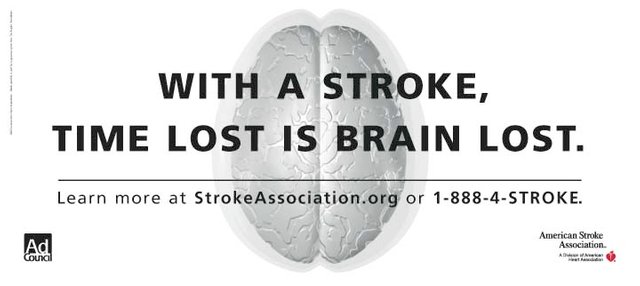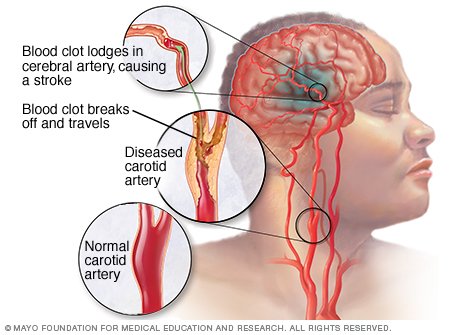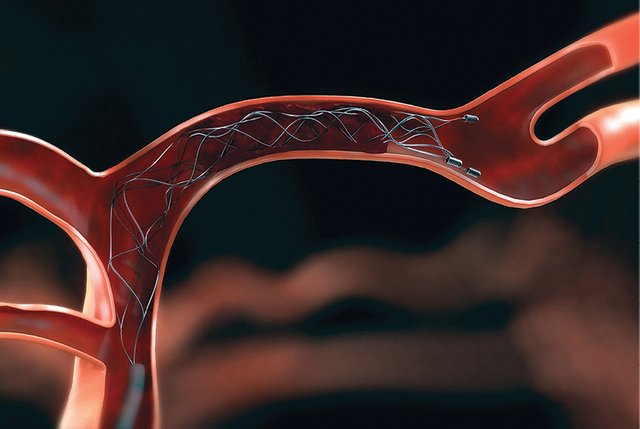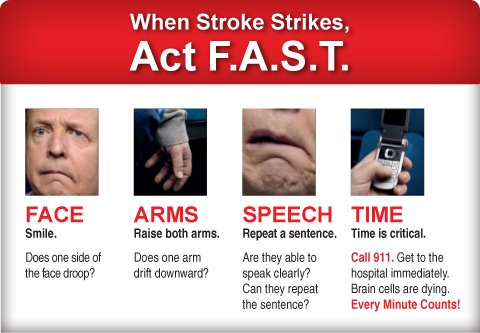Act FAST - Recognizing a Stroke, Rapid Treatment and Emerging Interventions for Acute Embolic Strokes
With cerebrovascular disease, time is brain.
( )
)
Inspired by @breakingtonight's post https://steemit.com/story/@breakingtonight/my-video-blog-vlog-talking-with-my-dad-about-his-stroke-experience-and-steemit, I wanted to write a little bit about strokes, and how to help realize when one is taking place so that you can help someone get to proper medical care in time.
For the longest time, cerebrovascular disease and stroke was an untreatable tragedy - there was little we could do except -diagnose- at stroke, with the best therapy being aimed towards rehabilitation from the loss of function, and identifying the cause and risk factors of stroke to prevent future ones. Medicine had very little to offer anyone suffering an acute stroke other than treatment aimed at the symptoms - and as a doctor, I can tell you how frustrating it is to not be able to -do- something.
But no longer!. Emerging therapies are making a huge difference in patients lives, and are providing a way to arrest strokes in their tracks - provided we get to a patient in time.
First, though, what is a stroke? Quite basically, a stroke is the loss of blood flow, and thus nutrients and oxygen, to the brain. And that's important, because the brain is neuron filled and ravenous. While only taking up 1-3% of the weight of the body, it demands a whopping 15% of the body's bloodflow, and up to 20% of the glucose usage. Glucose is a rapidly metabolized fuel, and neurons rely on aerobic metabolism to keep their functions rolling - which means glucose and oxygen are critical. And if that critical supply of nutrients is stopped, neurons quickly begin to die.
Ischemic strokes occur when one of the areas of the cerebrum loses that blood flow either through an embolic source such as a traveling blood clot clogs up the pipes to the brain, or loss of flow because of atherosclerotic disease - which is the buildup of gunk like cholesterol and calcium inside blood, where blood flow struggles down a choked off vessel.
( )
)
This is similar to coronary artery disease and heart attack, when a cardiac blood vessel gets blocked, dies, and heart muscle becomes ischemic. Cardiologists are able to treat acute myocardial infarction (a heart attack) by going in and busting up that clot and opening up the artery. And now, neurovascular interventions are taking the same approach. In 1995 an article was published in the New England Journal of Medicine detailing the use of Tissue Plasminogen Activator, or TPA, for acute stroke. TPA is a clot busting drug, and it is used to bust apart the acute thrombus. Sort of like pouring Drano down a sink, in our pipe analogy. TPA, when used early, was shown to lead to a better chance of functional recovery in outcome scores. However - time is brain. TPA can actually cause hemorrhages in the brain if given to a patient who has had a stroke for too long, because the blood vessels and brain tissues become so damaged that improved flow will just break through. And so TPA can only be given in the 3 hours after an onset of a stroke, with some patients eligible up to 4.5 hours after.
So you can imagine how someone sitting in an ER for 3 hours, or who lives on a farm 2 hours away from the city, or decides to sleep off that weird tingling sensation in their face can quickly cut themselves out of the critical time window.
And back to our pipe analogy - if we can use Drano to clean out pipes - we could also think about going in and taking a clot out ourselves. That's called mechanical thrombectomy, which is exactly similar to the way interventional cardiologists go in to the cath lab and open up blood vessels in the heart. Using a catheter snaked in from the groin, we can travel up from the femoral artery, into the intracranial blood vessels, and snag a clot out, restoring blood flow (and hopefully making those brain cells much more happy!)
And of course, I'm more happy as well, because plucking out crap from within-veins is not in-vain!
( )
)
If TPA is Drano, then endovascular therapy is Roto-rooter. However, that's again only safe up to 6 hours post stroke.
The majority of patients never qualify for these treatments, because they never make it to the hospital on time. Whereas many people know the signs and symptoms of a heart attack - crushing chest pain, tiredness, left arm pain, shortness of breath, and to get to the doctor FAST, strokes can be subtle and hard to realize. However, use of the Act FAST mnemonic can help people in the community recognize a stroke starting to occur and get someone to help faster. Since the brain is in two halves, controlling the opposite side of the body, a stroke on one side causes a person to be asymmetric - one side won't work as well as the other, and it is upon that critical distinction the diagnosis can hinge.
( )
)
If someone has a unilateral loss of function or weakness , they should be evaluated by a physician. Call 911 and help get that person to the care they need.
I have seen patients come in hemiplegic - essentially paralyzed from a large left MCA stroke, on one side of their body, have the blood clot lysed or the clot taken out, whom is able to start talking, walking, and getting back to normal. In the past - a person like that would have been completely debilitated. Nursing home bound, requiring total care from their families, and often not able to meaningfully interact with their loved ones.
The recovery, even with successful treatment, can be long and complicated. But if we can get someone back to their family, get a person back to enjoying life, travel, golf - or even back to the next season of Game of Thrones...
then we've all succeeded. Both as a community, and a healthcare system.
Remember - Act FAST!
Do you have a stroke story, or experience you'd like to share? Please do so in the comments.
Feel free to follow / resteem. Questions or other commentary are welcome!
Image Credits:
American Stroke Association
National Stroke Association
South County Health
Solitaire Stent Retriever
MNIV
@my-name-in-vein
I want to thank your for posting this and promoting stroke awareness. My father suffered a stroke and it was a devastating experience. Thankfully he survived, but he still has many challenges. I hope this information will wake people up to the warning signs so they can do something about it if it ever happened to them or a loved one.
Thanks @my-name-in-vein, I saw your up vote on my post this morning "200 to 300 followers in 4 days Thanks to all 306 of you!" and came here to follow you and check your blog an up vote a post. Good Post, important information. I'll be seeing you around.